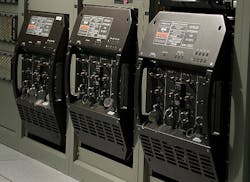Navy orders shipboard radios from General Dynamics for surface warships and submarines
SAN DIEGO, 5 Aug. 2015. U.S. Navy shipboard communications experts are placing a $29 million order with General Dynamics Corp. to provide AN/USC-61(C) digital modular shipboard radios for Navy surface warships and submarines.
Officials of the Space and Naval Warfare Systems Command (SPAWAR) in San Diego, announced a contract modification Tuesday to the General Dynamics Mission Systems segment in Scottsdale, Ariz., for the continued production of AN/USC-61(C) digital modular radios (DMRs), initial sparing components, and related supplies and services.
The General Dynamics AN/USC-61(C) radio enables surface ships and submarines to communicate over high frequency (HF), ultra-high frequency (UHF) line of sight, UHF satellite communications (SATCOM), and very high frequency (VHF) frequencies.
This contract includes options that could bring the total value of the contract to $300 million.
The AN/USC-61(C) is a maritime software-defined radio (SDR) that has become standard for the U.S. Military. The compact, multi-channel DMR provides several different waveforms and multi-level information security for voice and data communications.
Software-defined radio waveforms are computer programs that enable SDR-enable radios to operate on different frequency bands with different encryption and cyber security functions. The AN/USC-61(C) operates on Navy surface ships, submarines, and other military platforms using frequencies from 2 MHz to 2 GHz.
General Dynamics has certified the DMR to pass secure voice and data at multiple independent levels of security (MILS) over HF, VHF, UHF, and SATCOM channels, and to withstand the effects of electromagnetic interference and other harsh operating conditions.
The DMR also is certified by the Joint Interoperability Test Command (JITC) to be compliant with the U.S. government’s MIL-STD-188-181B/182A/183A requirements for UHF SATCOM.
story continues below
General Dynamics built the AN/USC-61(C) using open-architecture standards. The radio includes Embedded type 1 encryption; embedded red/black baseband switching and routing; co-site performance; reduced manpower requirements; single point of control for HF/VHF/UHF/SATCOM radio communications; and built-in test (BIT).
On this contract modification General Dynamics will do the work in Scottsdale, Ariz.; Vista, Calif.); and Johnstown, Pa., and should be finished by September 2017.
For more information contact General Dynamics Mission Systems online at www.gdc4s.com, or SPAWAR at www.spawar.navy.mil.

